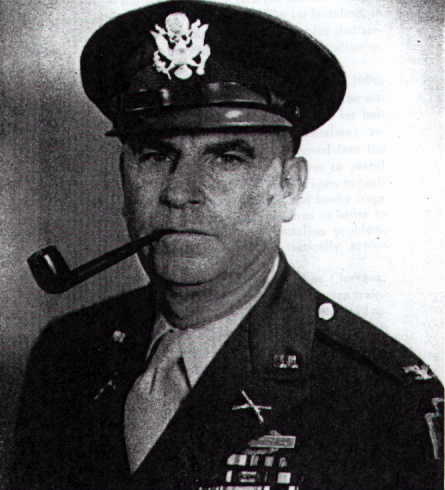When Hurley E. Fuller was born on November 27, 1894, in Texas, his father, John, was 30 and his mother, Dealia, was 27. He had one son with Nell Frances Hodges. He then married Matilda Armine Glidden on June 27, 1936, in Kingsville, Texas.
Col. Fuller was enrolled at the University of Texas in Austin, Texas and attended from the Fall of 1913 to the Spring of 1916. He joined the Army on 17 May 1916 and was commissioned on 23 Mar 1917 (during WWI).
Col. Fuller was the Commanding Officer of the 2nd Infantry Division, 23rd Infantry commencing on October 19, 1943 and presumably until July 11, 1944 when Lt. COL. Jay B. Loveless took over. He commanded the 23rd Infantry Regiment of the 2nd Infantry Division from June 6, 1944 to June 16, 1944. During the Battle of the Bulge, COL. Fuller commanded the US Army 28th Infantry Division’s 110th Regimental Combat Team (RCT). The 110th RCT consisted of the 110th Infantry Regiment and many attached units. Most of the fighters were moved back to Germany to protect it from the numerous allied bombing raids. The 110th was hit the hardest on 16 Dec and Fuller was handicapped because one infantry Bn was the division reserve and was not released to him for about 24 crucial hours and the division commander tried to get a picture of what was happening.
COL. Fuller was captured during the Battle of the Bulge in the Ardennes forest region around the town of Clervaux. He was one of 95,532 POW’s in WW-II/Europe. On the night of the 17th while searching for his second battalion and trying to return to the East bank of the Clerve River, he and a small group of men encountered Germans at every turn. On the morning of the 18th he and a Lt Wight, came upon the remnants of the 630th Tank Destroyer Battalion who were trying to turn around. They were encircled by Germans and Fuller ordered the equipment destroyed and he personally lead a small force to a nearby hill where they dug in. That night he ordered them to break into small groups and escape on their own. Fuller and a few men, Lt Wight among them went about a mile and stumbled into a German assembly area. One of the men panicked and started shouting "Camerade". Fuller and the remainder tried to run, but he was knocked out and when he came to he had a flesh wound from a bayonet in his stomach. Once they found out who he was they sent him back to the 2nd Panzer Division Headquarters at Bockholtz”. A detailed account of COL. Fuller’s capture can be found on page 286 of McDonalds book, “A Time for Trumpets”.
COL. Fuller did not escape from the Germans, he was liberated by the Germans deserting their post as the Russian advance was quickly approaching. Fuller talked a friendly German Guard, Paul Hegel, into turning the camp over to him along with the weapons. Fuller then assumed command of the camp. When the Russians came, he dressed HEGEL in an AMERICAN uniform in return for his assistance, and took him with him when he was repatriated to Italy. Upon being discovered, Fuller was investigated by the Army Inspector General for consorting with and giving comfort to the enemy, but when they found out that Hegel was instrumental in saving many Allied lives, they exonerated Fuller. Upon his return to the US Army, he was severely reprimanded or possibly court-martialed for wearing the uniform of an enemy. COL. Fuller wrote a letter on 22-Feb-45 to the Commanding General, 28th Infantry Division regarding his capture and the events surrounding his capture, imprisonment and release.
Col. Fuller also served in the Korean war. It is believed that he was still on active duty in 1950 and maybe longer. He died on April 29, 1975 at the age of 80 in San Antonio, Texas and is now buried in the Fort Sam Houston National Cemetery, San Antonio, Bexar County, Texas, USA.
Source of information: www.findagrave.com, http://www.lonestar-mvpa.org, www.ancestry.com

PRIVATE CITIZENS SUPPORTING AMERICA'S HERITAGE
American
War Memorials Overseas, Inc.
War Memorials Overseas, Inc.
Fuller Hurley E.
Name:
Hurley E. Fuller
Rank:
Colonel
Serial Number:
Unit:
110th Infantry Regiment, 28th Division
Date of Death:
1975-04-29
State:
Texas
Cemetery:
Fort Sam Houston National Cemetery, Texas
Plot:
Section PC
Row:
Grave:
42
Decoration:
Distinguished Service Medal for Meritorious Service, Silver Star Medal, Bro
Comments:
